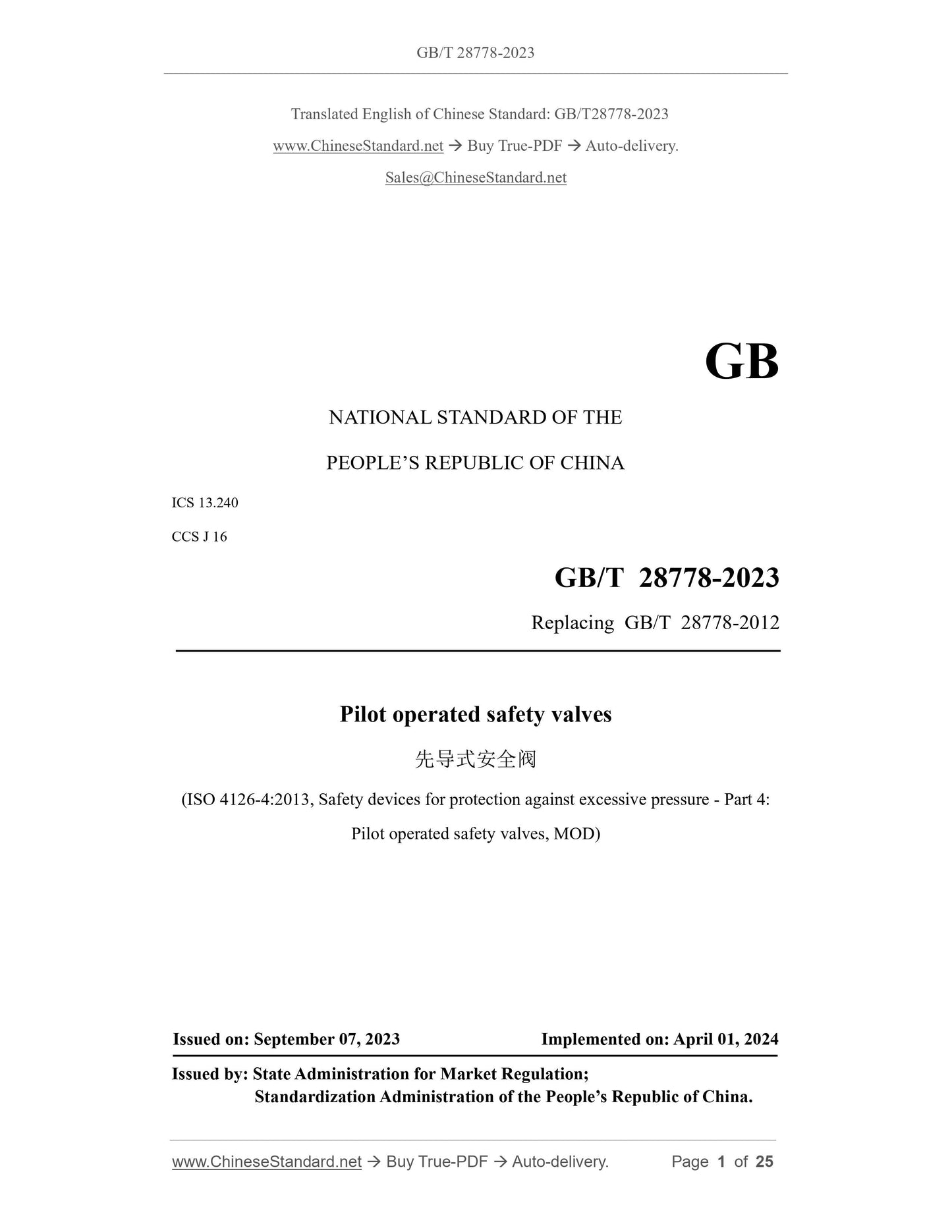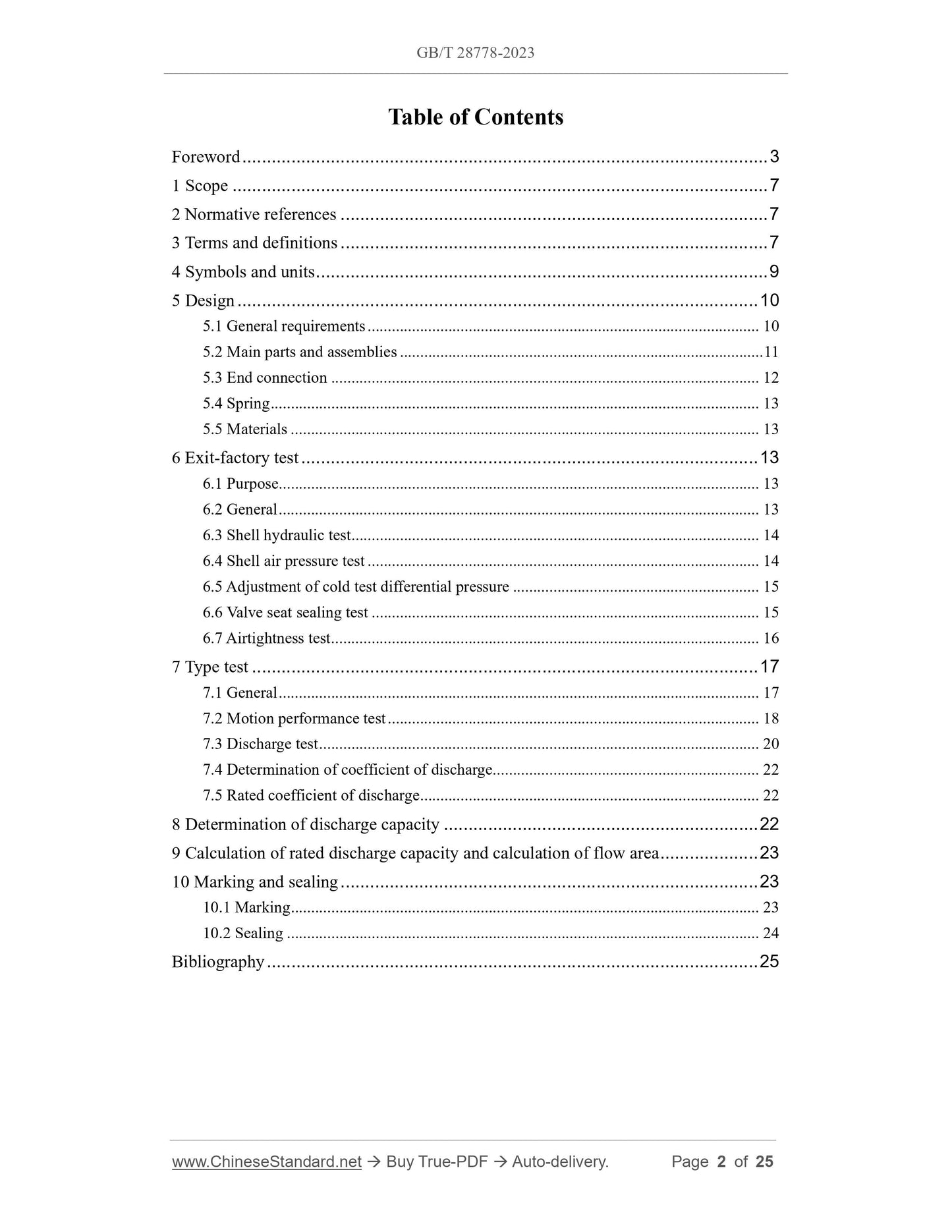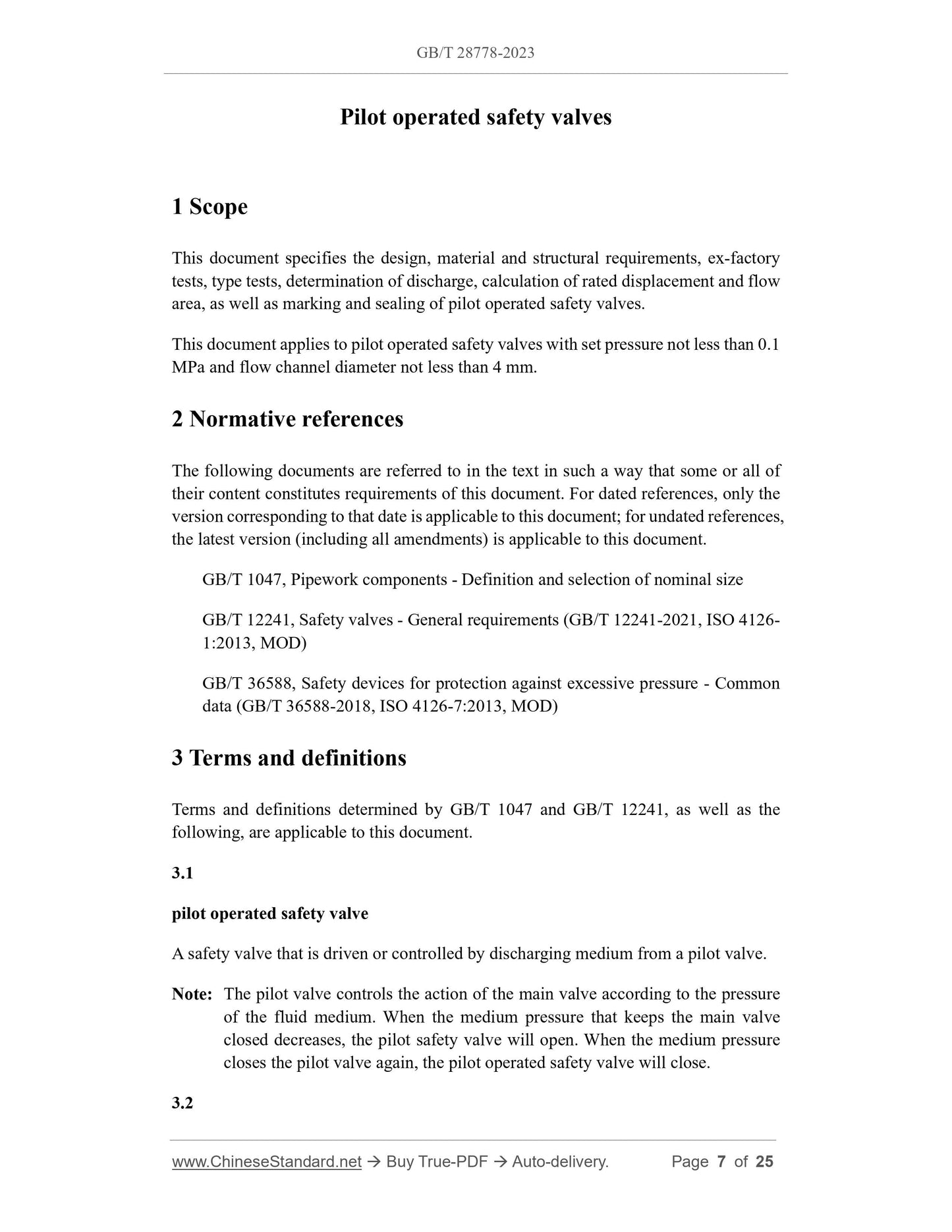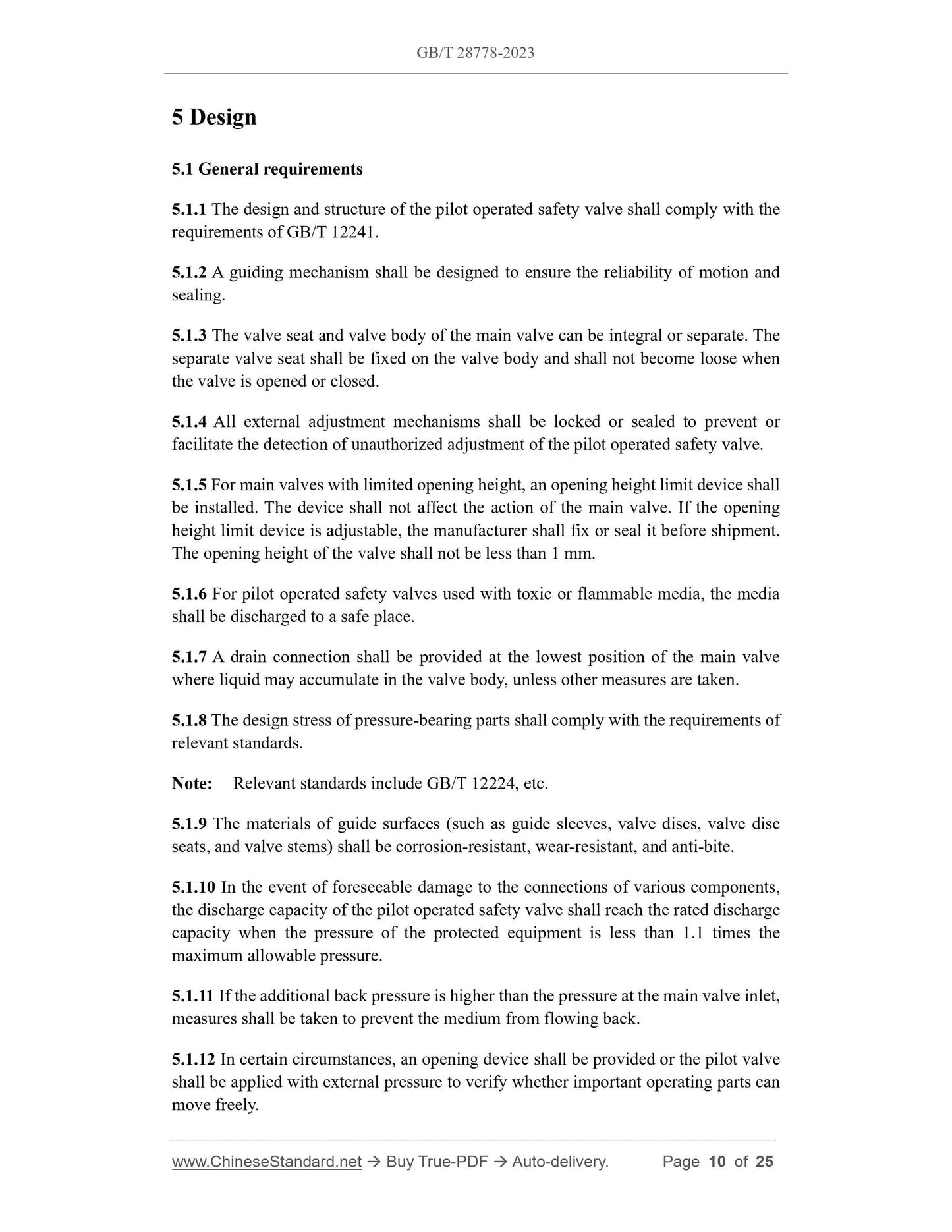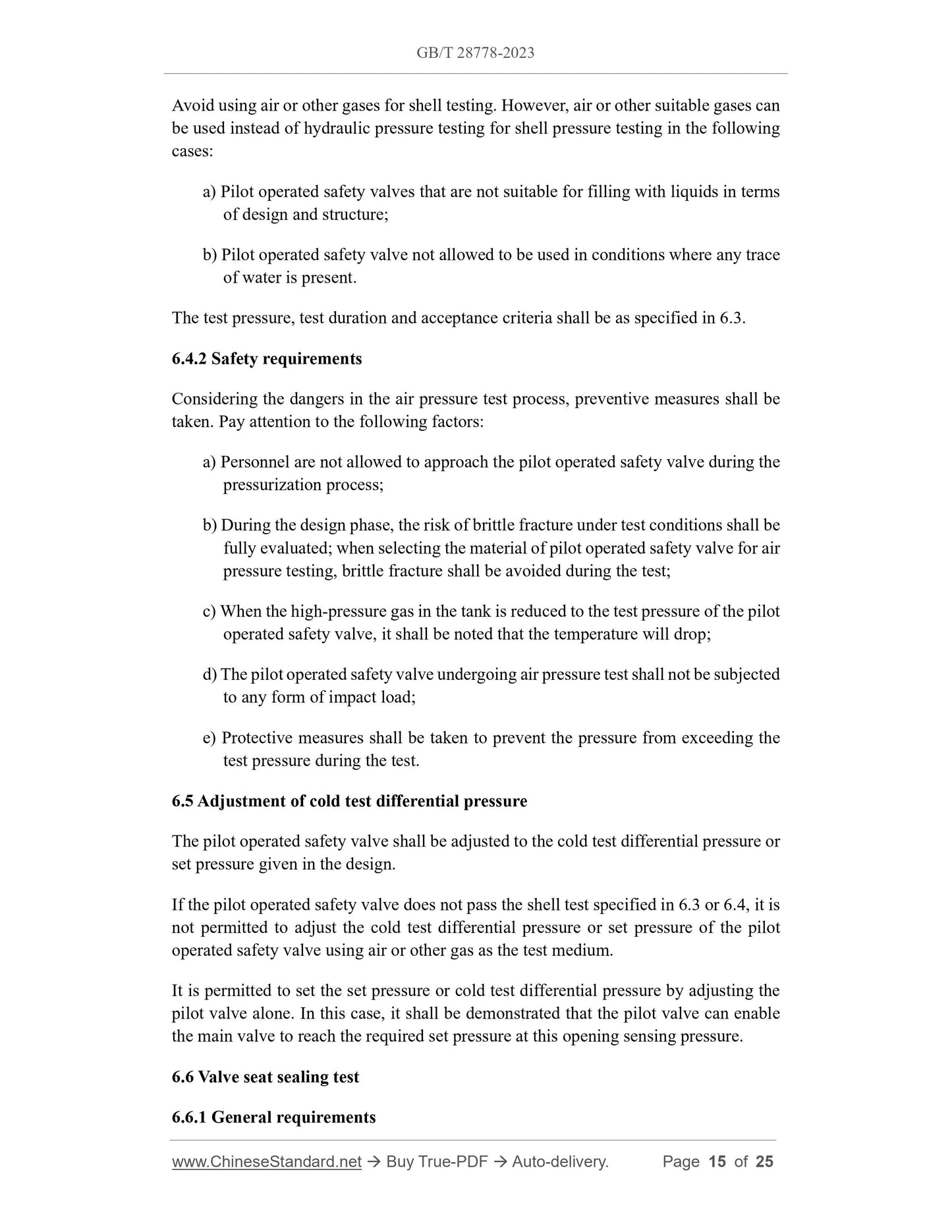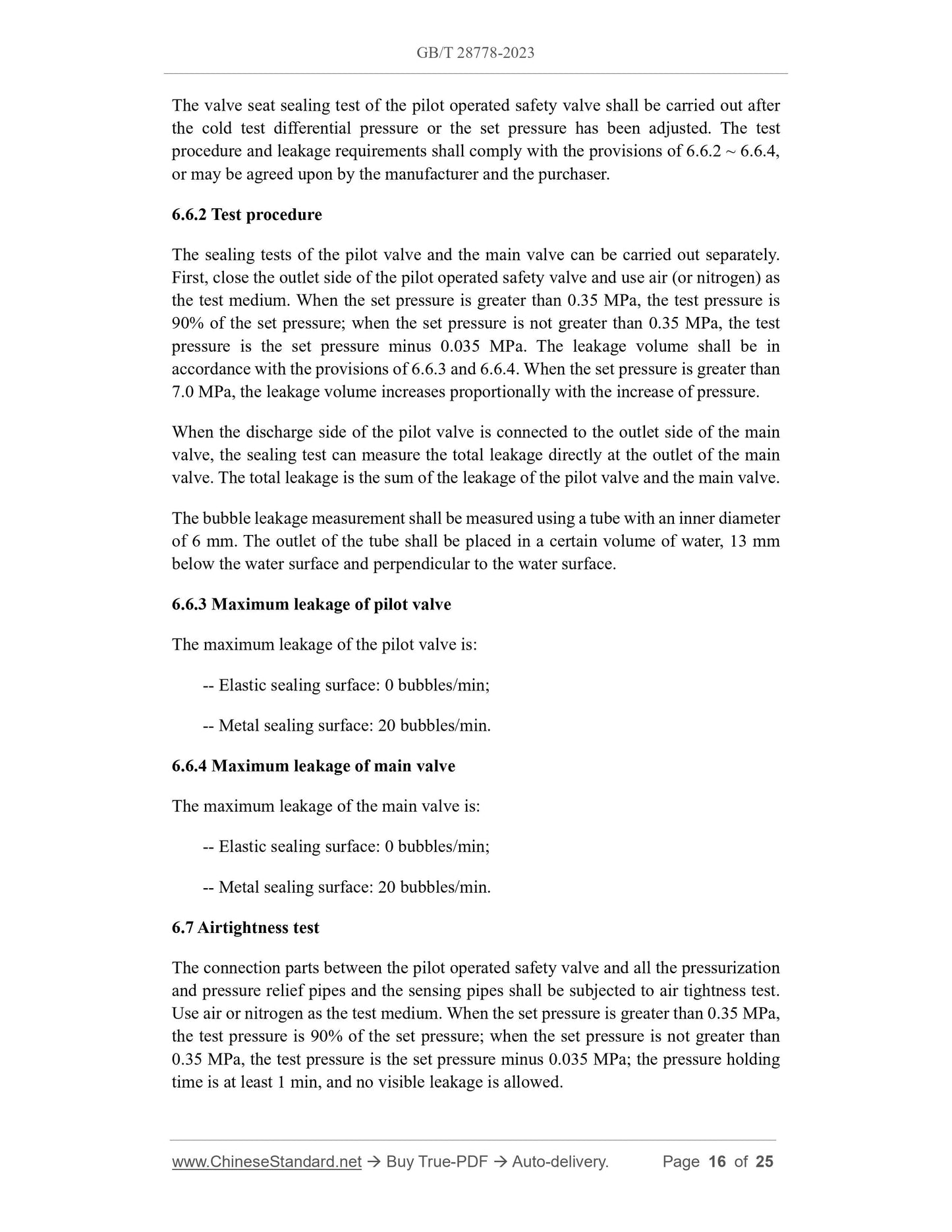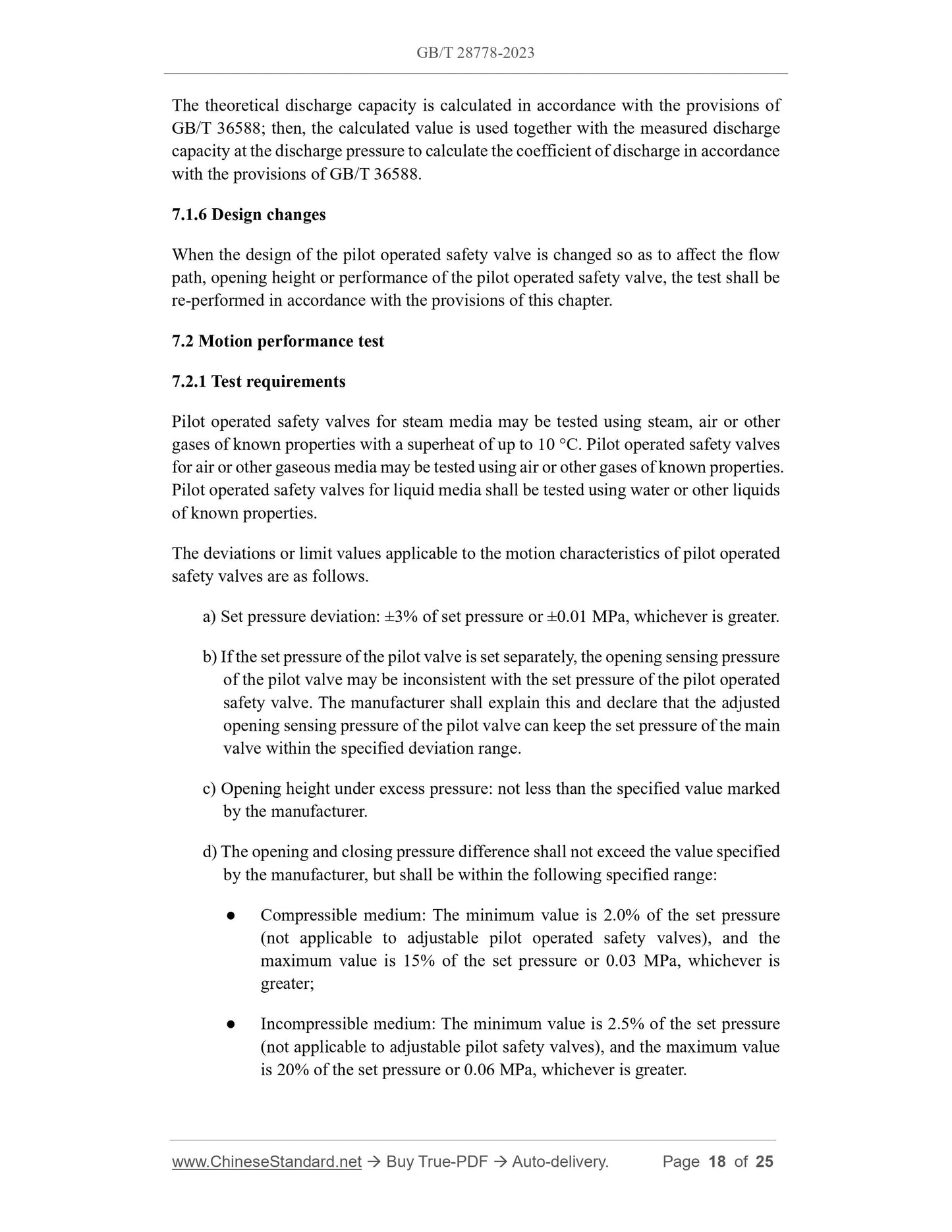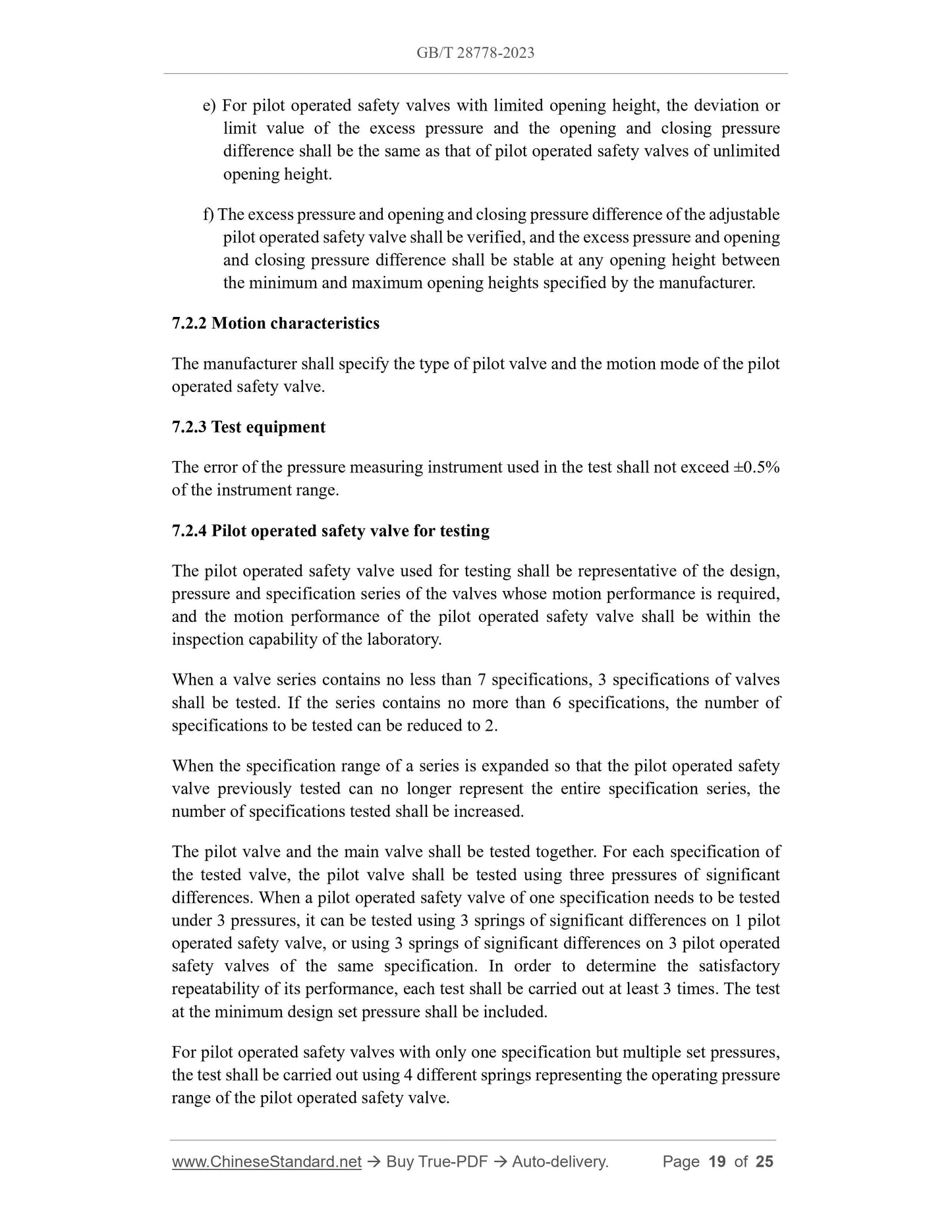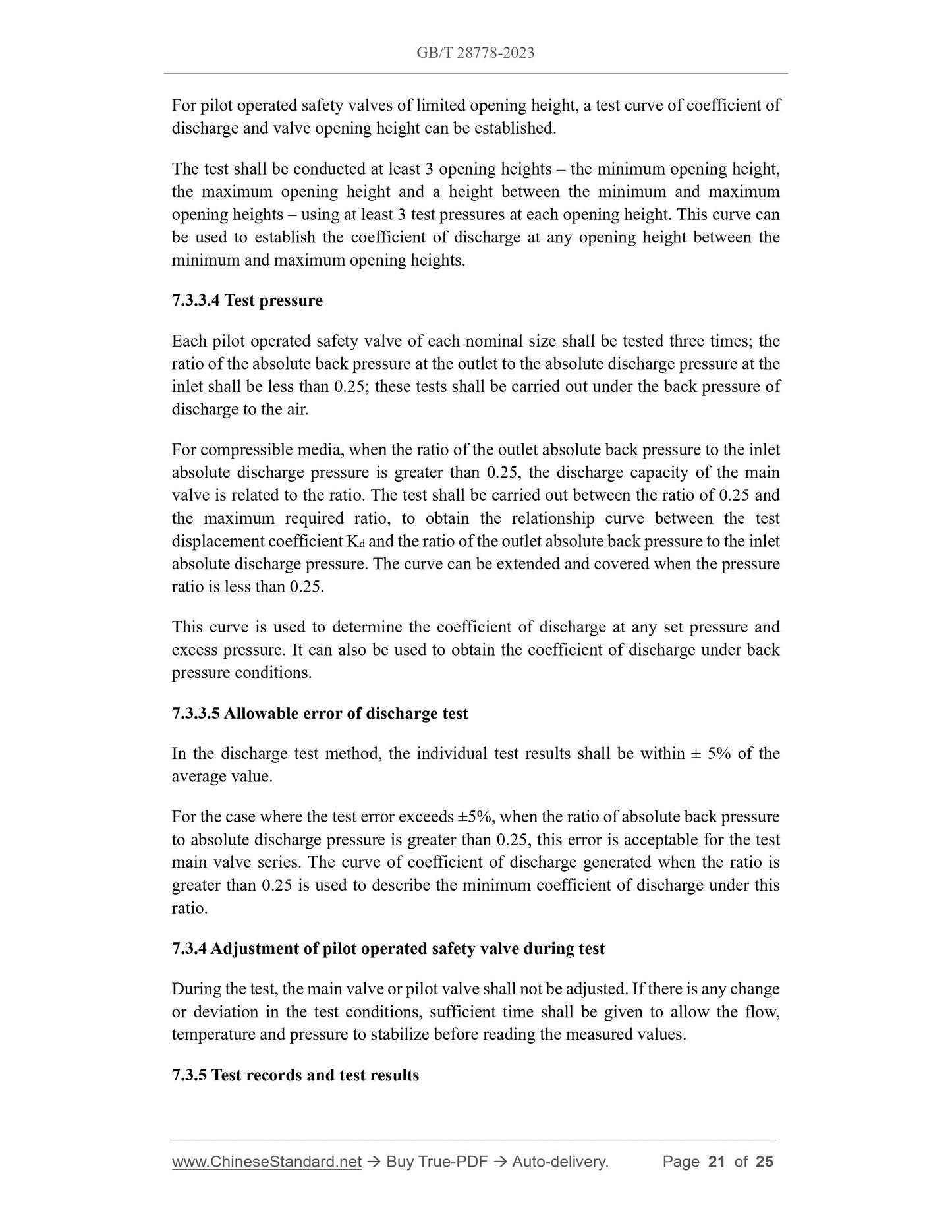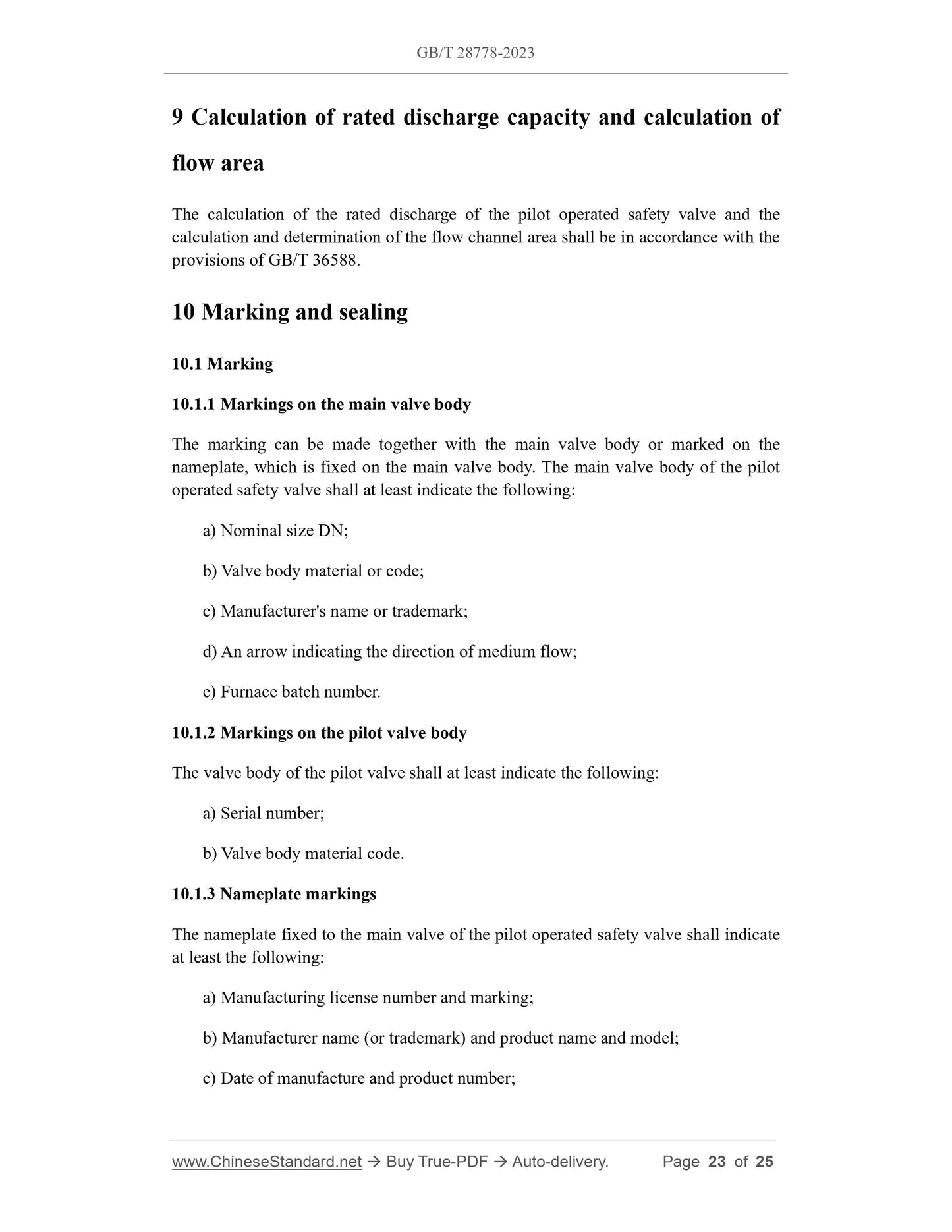1
/
of
10
PayPal, credit cards. Download editable-PDF and invoice in 1 second!
GB/T 28778-2023 English PDF (GBT28778-2023)
GB/T 28778-2023 English PDF (GBT28778-2023)
Regular price
$325.00 USD
Regular price
Sale price
$325.00 USD
Unit price
/
per
Shipping calculated at checkout.
Couldn't load pickup availability
Delivery: 3 seconds. Download true-PDF + Invoice.
Get QUOTATION in 1-minute: Click GB/T 28778-2023
Historical versions: GB/T 28778-2023
Preview True-PDF (Reload/Scroll if blank)
GB/T 28778-2023: Pilot operated safety valves
GB/T 28778-2023
GB
NATIONAL STANDARD OF THE
PEOPLE’S REPUBLIC OF CHINA
ICS 13.240
CCS J 16
Replacing GB/T 28778-2012
Pilot operated safety valves
(ISO 4126-4:2013, Safety devices for protection against excessive pressure - Part 4:
Pilot operated safety valves, MOD)
ISSUED ON: SEPTEMBER 07, 2023
IMPLEMENTED ON: APRIL 01, 2024
Issued by: State Administration for Market Regulation;
Standardization Administration of the People’s Republic of China.
Table of Contents
Foreword ... 3
1 Scope ... 7
2 Normative references ... 7
3 Terms and definitions ... 7
4 Symbols and units ... 9
5 Design ... 10
5.1 General requirements ... 10
5.2 Main parts and assemblies ... 11
5.3 End connection ... 12
5.4 Spring ... 13
5.5 Materials ... 13
6 Exit-factory test ... 13
6.1 Purpose... 13
6.2 General ... 13
6.3 Shell hydraulic test ... 14
6.4 Shell air pressure test ... 14
6.5 Adjustment of cold test differential pressure ... 15
6.6 Valve seat sealing test ... 15
6.7 Airtightness test ... 16
7 Type test ... 17
7.1 General ... 17
7.2 Motion performance test ... 18
7.3 Discharge test ... 20
7.4 Determination of coefficient of discharge ... 22
7.5 Rated coefficient of discharge ... 22
8 Determination of discharge capacity ... 22
9 Calculation of rated discharge capacity and calculation of flow area ... 23
10 Marking and sealing ... 23
10.1 Marking ... 23
10.2 Sealing ... 24
Bibliography ... 25
Pilot operated safety valves
1 Scope
This document specifies the design, material and structural requirements, ex-factory
tests, type tests, determination of discharge, calculation of rated displacement and flow
area, as well as marking and sealing of pilot operated safety valves.
This document applies to pilot operated safety valves with set pressure not less than 0.1
MPa and flow channel diameter not less than 4 mm.
2 Normative references
The following documents are referred to in the text in such a way that some or all of
their content constitutes requirements of this document. For dated references, only the
version corresponding to that date is applicable to this document; for undated references,
the latest version (including all amendments) is applicable to this document.
GB/T 1047, Pipework components - Definition and selection of nominal size
GB/T 12241, Safety valves - General requirements (GB/T 12241-2021, ISO 4126-
1:2013, MOD)
GB/T 36588, Safety devices for protection against excessive pressure - Common
data (GB/T 36588-2018, ISO 4126-7:2013, MOD)
3 Terms and definitions
Terms and definitions determined by GB/T 1047 and GB/T 12241, as well as the
following, are applicable to this document.
3.1
pilot operated safety valve
A safety valve that is driven or controlled by discharging medium from a pilot valve.
Note: The pilot valve controls the action of the main valve according to the pressure
of the fluid medium. When the medium pressure that keeps the main valve
closed decreases, the pilot safety valve will open. When the medium pressure
closes the pilot valve again, the pilot operated safety valve will close.
3.2
5 Design
5.1 General requirements
5.1.1 The design and structure of the pilot operated safety valve shall comply with the
requirements of GB/T 12241.
5.1.2 A guiding mechanism shall be designed to ensure the reliability of motion and
sealing.
5.1.3 The valve seat and valve body of the main valve can be integral or separate. The
separate valve seat shall be fixed on the valve body and shall not become loose when
the valve is opened or closed.
5.1.4 All external adjustment mechanisms shall be locked or sealed to prevent or
facilitate the detection of unauthorized adjustment of the pilot operated safety valve.
5.1.5 For main valves with limited opening height, an opening height limit device shall
be installed. The device shall not affect the action of the main valve. If the opening
height limit device is adjustable, the manufacturer shall fix or seal it before shipment.
The opening height of the valve shall not be less than 1 mm.
5.1.6 For pilot operated safety valves used with toxic or flammable media, the media
shall be discharged to a safe place.
5.1.7 A drain connection shall be provided at the lowest position of the main valve
where liquid may accumulate in the valve body, unless other measures are taken.
5.1.8 The design stress of pressure-bearing parts shall comply with the requirements of
relevant standards.
Note: Relevant standards include GB/T 12224, etc.
5.1.9 The materials of guide surfaces (such as guide sleeves, valve discs, valve disc
seats, and valve stems) shall be corrosion-resistant, wear-resistant, and anti-bite.
5.1.10 In the event of foreseeable damage to the connections of various components,
the discharge capacity of the pilot operated safety valve shall reach the rated discharge
capacity when the pressure of the protected equipment is less than 1.1 times the
maximum allowable pressure.
5.1.11 If the additional back pressure is higher than the pressure at the main valve inlet,
measures shall be taken to prevent the medium from flowing back.
5.1.12 In certain circumstances, an opening device shall be provided or the pilot valve
shall be applied with external pressure to verify whether important operating parts can
move freely.
Avoid using air or other gases for shell testing. However, air or other suitable gases can
be used instead of hydraulic pressure testing for shell pressure testing in the following
cases:
a) Pilot operated safety valves that are not suitable for filling with liquids in terms
of design and structure;
b) Pilot operated safety valve not allowed to be used in conditions where any trace
of water is present.
The test pressure, test duration and acceptance criteria shall be as specified in 6.3.
6.4.2 Safety requirements
Considering the dangers in the air pressure test process, preventive measures shall be
taken. Pay attention to the following factors:
a) Personnel are not allowed to approach the pilot operated safety valve during the
pressurization process;
b) During the design phase, the risk of brittle fracture under test conditions shall be
fully evaluated; when selecting the material of pilot operated safety valve for air
pressure testing, brittle fracture shall be avoided during the test;
c) When the high-pressure gas in the tank is reduced to the test pressure of the pilot
operated safety valve, it shall be noted that the temperature will drop;
d) The pilot operated safety valve undergoing air pressure test shall not be subjected
to any form of impact load;
e) Protective measures shall be taken to prevent the pressure from exceeding the
test pressure during the test.
6.5 Adjustment of cold test differential pressure
The pilot operated safety valve shall be adjusted to the cold test differential pressure or
set pressure given in the design.
If the pilot operated safety valve does not pass the shell test specified in 6.3 or 6.4, it is
not permitted to adjust the cold test differential pressure or set pressure of the pilot
operated safety valve using air or other gas as the test medium.
It is permitted to set the set pressure or cold test differential pressure by adjusting the
pilot valve alone. In this case, it shall be demonstrated that the pilot valve can enable
the main valve to reach the required set pressure at this opening sensing pressure.
6.6 V...
Get QUOTATION in 1-minute: Click GB/T 28778-2023
Historical versions: GB/T 28778-2023
Preview True-PDF (Reload/Scroll if blank)
GB/T 28778-2023: Pilot operated safety valves
GB/T 28778-2023
GB
NATIONAL STANDARD OF THE
PEOPLE’S REPUBLIC OF CHINA
ICS 13.240
CCS J 16
Replacing GB/T 28778-2012
Pilot operated safety valves
(ISO 4126-4:2013, Safety devices for protection against excessive pressure - Part 4:
Pilot operated safety valves, MOD)
ISSUED ON: SEPTEMBER 07, 2023
IMPLEMENTED ON: APRIL 01, 2024
Issued by: State Administration for Market Regulation;
Standardization Administration of the People’s Republic of China.
Table of Contents
Foreword ... 3
1 Scope ... 7
2 Normative references ... 7
3 Terms and definitions ... 7
4 Symbols and units ... 9
5 Design ... 10
5.1 General requirements ... 10
5.2 Main parts and assemblies ... 11
5.3 End connection ... 12
5.4 Spring ... 13
5.5 Materials ... 13
6 Exit-factory test ... 13
6.1 Purpose... 13
6.2 General ... 13
6.3 Shell hydraulic test ... 14
6.4 Shell air pressure test ... 14
6.5 Adjustment of cold test differential pressure ... 15
6.6 Valve seat sealing test ... 15
6.7 Airtightness test ... 16
7 Type test ... 17
7.1 General ... 17
7.2 Motion performance test ... 18
7.3 Discharge test ... 20
7.4 Determination of coefficient of discharge ... 22
7.5 Rated coefficient of discharge ... 22
8 Determination of discharge capacity ... 22
9 Calculation of rated discharge capacity and calculation of flow area ... 23
10 Marking and sealing ... 23
10.1 Marking ... 23
10.2 Sealing ... 24
Bibliography ... 25
Pilot operated safety valves
1 Scope
This document specifies the design, material and structural requirements, ex-factory
tests, type tests, determination of discharge, calculation of rated displacement and flow
area, as well as marking and sealing of pilot operated safety valves.
This document applies to pilot operated safety valves with set pressure not less than 0.1
MPa and flow channel diameter not less than 4 mm.
2 Normative references
The following documents are referred to in the text in such a way that some or all of
their content constitutes requirements of this document. For dated references, only the
version corresponding to that date is applicable to this document; for undated references,
the latest version (including all amendments) is applicable to this document.
GB/T 1047, Pipework components - Definition and selection of nominal size
GB/T 12241, Safety valves - General requirements (GB/T 12241-2021, ISO 4126-
1:2013, MOD)
GB/T 36588, Safety devices for protection against excessive pressure - Common
data (GB/T 36588-2018, ISO 4126-7:2013, MOD)
3 Terms and definitions
Terms and definitions determined by GB/T 1047 and GB/T 12241, as well as the
following, are applicable to this document.
3.1
pilot operated safety valve
A safety valve that is driven or controlled by discharging medium from a pilot valve.
Note: The pilot valve controls the action of the main valve according to the pressure
of the fluid medium. When the medium pressure that keeps the main valve
closed decreases, the pilot safety valve will open. When the medium pressure
closes the pilot valve again, the pilot operated safety valve will close.
3.2
5 Design
5.1 General requirements
5.1.1 The design and structure of the pilot operated safety valve shall comply with the
requirements of GB/T 12241.
5.1.2 A guiding mechanism shall be designed to ensure the reliability of motion and
sealing.
5.1.3 The valve seat and valve body of the main valve can be integral or separate. The
separate valve seat shall be fixed on the valve body and shall not become loose when
the valve is opened or closed.
5.1.4 All external adjustment mechanisms shall be locked or sealed to prevent or
facilitate the detection of unauthorized adjustment of the pilot operated safety valve.
5.1.5 For main valves with limited opening height, an opening height limit device shall
be installed. The device shall not affect the action of the main valve. If the opening
height limit device is adjustable, the manufacturer shall fix or seal it before shipment.
The opening height of the valve shall not be less than 1 mm.
5.1.6 For pilot operated safety valves used with toxic or flammable media, the media
shall be discharged to a safe place.
5.1.7 A drain connection shall be provided at the lowest position of the main valve
where liquid may accumulate in the valve body, unless other measures are taken.
5.1.8 The design stress of pressure-bearing parts shall comply with the requirements of
relevant standards.
Note: Relevant standards include GB/T 12224, etc.
5.1.9 The materials of guide surfaces (such as guide sleeves, valve discs, valve disc
seats, and valve stems) shall be corrosion-resistant, wear-resistant, and anti-bite.
5.1.10 In the event of foreseeable damage to the connections of various components,
the discharge capacity of the pilot operated safety valve shall reach the rated discharge
capacity when the pressure of the protected equipment is less than 1.1 times the
maximum allowable pressure.
5.1.11 If the additional back pressure is higher than the pressure at the main valve inlet,
measures shall be taken to prevent the medium from flowing back.
5.1.12 In certain circumstances, an opening device shall be provided or the pilot valve
shall be applied with external pressure to verify whether important operating parts can
move freely.
Avoid using air or other gases for shell testing. However, air or other suitable gases can
be used instead of hydraulic pressure testing for shell pressure testing in the following
cases:
a) Pilot operated safety valves that are not suitable for filling with liquids in terms
of design and structure;
b) Pilot operated safety valve not allowed to be used in conditions where any trace
of water is present.
The test pressure, test duration and acceptance criteria shall be as specified in 6.3.
6.4.2 Safety requirements
Considering the dangers in the air pressure test process, preventive measures shall be
taken. Pay attention to the following factors:
a) Personnel are not allowed to approach the pilot operated safety valve during the
pressurization process;
b) During the design phase, the risk of brittle fracture under test conditions shall be
fully evaluated; when selecting the material of pilot operated safety valve for air
pressure testing, brittle fracture shall be avoided during the test;
c) When the high-pressure gas in the tank is reduced to the test pressure of the pilot
operated safety valve, it shall be noted that the temperature will drop;
d) The pilot operated safety valve undergoing air pressure test shall not be subjected
to any form of impact load;
e) Protective measures shall be taken to prevent the pressure from exceeding the
test pressure during the test.
6.5 Adjustment of cold test differential pressure
The pilot operated safety valve shall be adjusted to the cold test differential pressure or
set pressure given in the design.
If the pilot operated safety valve does not pass the shell test specified in 6.3 or 6.4, it is
not permitted to adjust the cold test differential pressure or set pressure of the pilot
operated safety valve using air or other gas as the test medium.
It is permitted to set the set pressure or cold test differential pressure by adjusting the
pilot valve alone. In this case, it shall be demonstrated that the pilot valve can enable
the main valve to reach the required set pressure at this opening sensing pressure.
6.6 V...
Share
